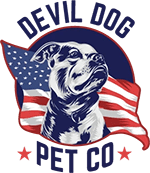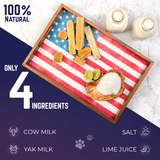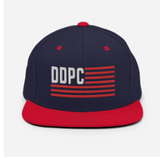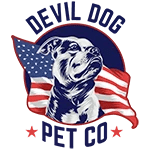Key Takeaways
- Getting a dog requires more than just buying gear; it demands preparation and commitment.
- Owning a dog involves taking on an extreme leadership role.
- Many first-time owners overlook essential supplies that help prevent behavioral issues.
- Having the right tools is crucial to avoid shelter surrenders.
Table of Contents
- The Commitment Comes First, What It Really Takes to Own a Dog
- Choose the Right Dog for Your Life, Energy, Space, and Temperament
- Essential Dog Supplies Checklist, Everything You Need Before Day One
- Home Preparation, Creating a Safe, Functional Dog Environment
- Nutrition Fundamentals, Choosing and Serving Food the Right Way
- Premium Chews for Mental Health and Dental Care
- Grooming and Hygiene, Routine to Keep Your Dog (and Home) Healthy
- Health and Emergency Planning, Proactive Steps for Safety and Wellbeing
- Devil Dog Leadership in Action, Sample Day and Common Solutions
- Devil Dog Pet Co. Mission, Better Leaders, Safer Chews, Fewer Shelter Dogs
What Do I Need for a Dog? The Ultimate Devil Dog Pet Co. Checklist for Extreme Dog Leadership
Getting a dog isn't about collecting gear, it's about stepping into an extreme leadership role that demands preparation, commitment, and the right tools. Most first-time owners focus on cute beds and toys while missing the mission-critical supplies that prevent behavioral disasters and shelter surrenders.
Before you ask "what do i need for a dog," ask yourself if you're ready for 10-15 years of daily leadership. This isn't a weekend hobby, it's a lifestyle overhaul that demands time, money, and mental bandwidth most people underestimate. Extra large elk antler chews are a great example of a product that supports both mental stimulation and dental health from day one.
Daily Time Investment: Plan for 1.5-4 hours split between walks (45-90 minutes), training sessions (15-20 minutes), feeding routines (20 minutes), grooming (10-15 minutes), and mental enrichment (30-60 minutes). Puppies and high-energy breeds hit the upper end; seniors and calm temperaments require less but never zero.
Financial Reality Check: Budget $1,200-$2,000 annually for food, preventive vet care, quality chews, and routine supplies. Keep an emergency fund of $3,000-$5,000, a single medical crisis can drain savings fast. The "cheap" dog doesn't exist; cutting corners on nutrition, training, or healthcare creates expensive problems later.
The Extreme Dog Leadership mindset boils down to one principle: "Results are on me." If your dog chews furniture, that's a leadership failure, not a "bad dog." If they're anxious, reactive, or destructive, you missed something in preparation, training, or management. Own the process, and you'll create a confident, chaos-free companion.
Download the FREE 10-Step Dog Prep Guide
Choose the Right Dog for Your Life, Energy, Space, and Temperament
The wrong dog-owner match creates 90% of behavioral problems that land dogs in shelters. Before you fall in love with a face, audit your lifestyle against breed characteristics, energy requirements, and space limitations.
Energy Assessment: Match your activity level honestly. A Border Collie needs 2+ hours of intense mental and physical work daily; a Basset Hound thrives with moderate walks and puzzle toys. Customer dogs we've worked with include marathon runners who adopted Cattle Dogs (perfect match) and retirees who chose senior Pit Bulls (equally perfect). Our dog Dexter required moderate exercise and high-value chews to manage his natural intensity.
| Factor | Puppy (8-16 weeks) | Adult (1-7 years) | Senior (7+ years) |
|---|---|---|---|
| Training Time | 3-4 hours daily | 1-2 hours daily | 30-60 minutes daily |
| Predictability | Unknown temperament | Established personality | Calm, settled behavior |
| Health Costs | Moderate (vaccines, spay/neuter) | Low (routine care) | High (age-related issues) |
Adoption vs. Breeder Decision: Rescue dogs come with unknown histories but proven temperaments you can assess during meet-and-greets. Reputable breeders offer health guarantees and predictable traits but require extensive research to avoid puppy mills. Both paths work when you prioritize temperament match over appearance and prepare for the specific needs of your chosen dog. For more guidance on choosing the right breed, you might find this article on the best dogs for families with young children helpful.
Essential Dog Supplies Checklist, Everything You Need Before Day One

Smart preparation prevents chaos. Stock these mission-critical supplies before your dog arrives, focusing on safety, containment, and behavior management over cute accessories that serve no functional purpose.
Safety and Identification: Start with a properly fitted collar (two-finger rule between collar and neck), durable ID tag with current phone number, and microchip registration. Add a 6-foot fixed-length leash, no retractables that teach pulling and create safety hazards.
Containment and Comfort: Size your crate so your dog can stand up, turn around, and lie down comfortably. Include a quality dog bed for daytime lounging, orthopedic foam for seniors, chew-resistant materials for puppies.
Feeding Essentials: Stainless steel bowls resist bacteria better than plastic. Choose raised feeders for large breeds to reduce neck strain. Stock a 30-day supply of high-quality kibble and premium chews like Devil Dog's elk antlers or yak chews for mental stimulation.
Safety and Emergency Kit: Dog-proof your home with cabinet locks, cord protectors, and baby gates. Assemble a first-aid kit with gauze, antiseptic, emergency vet contact, and copies of vaccination records.
Home Preparation, Creating a Safe, Functional Dog Environment
Your home becomes your dog's entire world, make it safe and structured. Effective preparation prevents expensive emergencies and sets clear boundaries from day one.
Puppy-Proofing Priorities: Secure electrical cords with covers, install cabinet locks on cleaning supplies, and remove small objects that pose choking hazards. Place baby gates at stairs and doorways to dangerous areas like garages or basements. Even adult dogs need time to learn house rules, prevention beats correction every time.
Containment Strategy: Position your dog's crate in a quiet corner away from high-traffic areas but not isolated from family activity. Add a comfortable bed, favorite toy, and water bowl. Create designated "safe zones" where your dog can decompress without interruption, this reduces anxiety and prevents resource guarding behaviors. For more on preventing anxiety, see what causes separation anxiety in dogs.
Essential Safety Checklist: Remove toxic plants (lilies, azaleas, sago palms), secure trash cans with tight lids, and store medications in high cabinets. Check fence lines for gaps and ensure gates latch securely. Install motion-sensor lights for nighttime potty breaks and keep a slip-lead by the door for quick access during emergencies.
Nutrition Fundamentals, Choosing and Serving Food the Right Way
| Food Type | Convenience | Nutrient Density | Cost | Best For |
|---|---|---|---|---|
| Dry Kibble | High | Moderate | Low-Moderate | Daily feeding, dental benefits |
| Wet/Canned | Moderate | High | Moderate-High | Picky eaters, hydration boost |
| Raw/Fresh | Low | Very High | High | Food sensitivities, maximum nutrition |
| Freeze-Dried | High | Very High | Very High | Travel, emergency backup |
Reading Labels Like a Pro: Look for named meat as the first ingredient, "chicken" beats "chicken meal," which beats "poultry by-product." Avoid foods with excessive fillers like corn gluten meal or artificial preservatives. AAFCO "Complete and Balanced" certification ensures minimum nutritional standards are met. For a comprehensive checklist on canine life stages and nutrition, see the AAHA Canine Life Stage Checklists.
Feeding Tools and Techniques: Stainless steel bowls resist bacteria and don't retain odors like plastic. Measure portions by weight, not volume, a "cup" of different kibbles can vary by 50 calories. Slow-feeder bowls prevent gulping and reduce bloat risk in deep-chested breeds. Fresh water should be available 24/7, refreshed daily.
Transition Protocol: Switch foods gradually over 7-10 days, mixing increasing amounts of new food with decreasing amounts of old. Monitor for digestive upset and adjust timing if needed. Sudden changes cause unnecessary stomach distress and food aversion.
Premium Chews for Mental Health and Dental Care

The right chew transforms destructive energy into productive behavior while supporting dental health. This isn't about treats, it's about giving your dog a job that satisfies natural instincts.
Elk Antler Chews, Maximum Durability: Devil Dog's whole elk antlers last weeks longer than rawhide or synthetic alternatives. Naturally shed by wild Rocky Mountain elk, these mineral-rich chews contain zero artificial additives. The dense bone structure forces slow, controlled gnawing that scrapes plaque while exercising jaw muscles. Size up from your dog's muzzle length to prevent swallowing hazards. Learn more about the pros and cons in are antlers for dogs a good idea.
Himalayan Yak Chews, Digestible Power: Crafted from yak and cow milk using traditional Nepalese methods, these protein-packed chews soften gradually with saliva. Unlike antlers, every bit is fully digestible, making them ideal for aggressive chewers prone to gulping. The rich flavor keeps dogs engaged for extended periods, reducing anxiety and boredom behaviors. For a unique treat, try Himalayan Dog Chew Nuggets for making yak chew cheese puffs.
Premium Bully Sticks, Single-Ingredient Safety: Made from 100% grass-fed beef pizzle, 12" braided bully sticks offer a long-lasting, digestible chew that supports dental health and satisfies natural chewing urges.
Grooming and Hygiene, Routine to Keep Your Dog (and Home) Healthy
Proper grooming prevents health issues while strengthening your leadership bond. Start with these core tools: slicker brush for most coat types, nail clippers sized to your dog's paws, dog-specific shampoo (human products disrupt pH balance), and ear cleaner formulated for canines.
Dental Care Through Strategic Chewing: Daily chews like elk antlers and yak sticks scrape plaque naturally while providing mental stimulation. Supplement with weekly tooth brushing using enzymatic paste, never human toothpaste, which contains toxic xylitol. For more on safe trimming, see this expert guide for safe trimming of black dog nails.
Bathing Guidelines: Most dogs need baths monthly unless they're outdoor athletes or have skin conditions. Use lukewarm water, rinse thoroughly to prevent skin irritation, and dry completely to avoid hot spots. Overbathing strips natural oils.
Shedding Management: Weekly brushing reduces loose hair by 80%. During shedding seasons, increase to every other day. High-quality nutrition also minimizes excessive shedding, another reason proper chews matter.
Health and Emergency Planning, Proactive Steps for Safety and Wellbeing
Schedule your first vet visit within 48 hours of bringing your dog home. Establish vaccination schedules, discuss spay/neuter timing, and create a baseline health record. Annual wellness exams catch problems early when treatment is most effective.
Emergency Kit Essentials: Gauze pads, medical tape, digital thermometer (normal dog temp: 101-102.5°F), hydrogen peroxide for induced vomiting (only if vet directs), emergency vet contact, and your dog's medical records in waterproof storage.
Warning Signs to Monitor: Changes in appetite, bathroom habits, energy levels, or behavior patterns. Difficulty breathing, excessive panting when cool, vomiting, or diarrhea lasting more than 24 hours require immediate veterinary attention.
Preventive Care Schedule: Monthly flea/tick prevention, quarterly heartworm testing, annual vaccinations, and biannual dental cleanings for dogs over three years old. Prevention costs less than treatment. For more on general dog care, visit the AVMA dog care resource.
Devil Dog Leadership in Action, Sample Day and Common Solutions

Successful dog ownership follows consistent daily structure. Here's a proven schedule that prevents behavioral problems before they start:
6:00 AM: Immediate potty break, then breakfast in crate while you prepare for the day.
7:30 AM: 20-minute walk focusing on loose-leash training.
12:00 PM: Midday potty break and 5-minute training session (sit, stay, come).
6:00 PM: Dinner followed by mental stimulation, puzzle toys or Devil Dog antler chew.
8:00 PM: Family time and second training session.
10:00 PM: Final potty break, then crate rest.
Solving Common First-Week Problems:
Chewing Furniture: Redirect immediately to appropriate chew, praise when they choose correctly. Remove temptation by managing access until habits form. For puppies, consider a puppy antler chew to encourage healthy chewing habits.
House Training Accidents: Clean with enzymatic cleaner, increase supervision, and reward outdoor success enthusiastically. Never punish accidents, they indicate insufficient leadership, not defiance.
Excessive Barking: Address the trigger, not the symptom. Provide adequate exercise, mental stimulation through appropriate chews, and consistent training responses.
Devil Dog Pet Co. Mission, Better Leaders, Safer Chews, Fewer Shelter Dogs
Every year, 3.3 million dogs enter U.S. shelters, with behavioral issues being the leading cause of surrender. These problems stem from inadequate leadership and inappropriate outlets for natural behaviors like chewing.
Devil Dog Pet Co. addresses this crisis through our Extreme Dog Leadership philosophy: owners who take full responsibility create confident, well-behaved dogs. Our premium chews, ethically sourced elk antlers, traditional Himalayan yak chews, and grass-fed bully sticks, provide safe, long-lasting outlets for natural behaviors while supporting dental health.
Our Veteran-Rooted Promise: Hand-inspected quality, transparent sourcing, and the Happy Tails Guarantee. When you choose Devil Dog products, you're supporting veteran entrepreneurs and contributing to organizations that provide service dogs to veterans at no cost.
Your Next Steps: Start with our Extreme Dog Leadership Guide, select appropriate chews for your dog's size and chewing style, and join our community of responsible owners who put leadership first. Together, we're proving that proper preparation and quality products create lasting human-dog partnerships.
Remember, what do I need for a dog isn't just about gathering supplies. It's about committing to daily leadership that transforms both you and your four-legged teammate into an unbreakable unit.
Download the FREE 10-Step Dog Prep Guide
Frequently Asked Questions
What essential supplies should I have before bringing a dog home to prevent behavioral issues?
Before bringing your dog home, gear up with a sturdy collar and leash, ID tags, a properly sized crate, food and water bowls, quality dog food, grooming tools, durable chew toys like elk antlers, waste bags, and a first-aid kit. These mission-critical supplies set the foundation for training, mental stimulation, and safety, key to preventing destructive behaviors and shelter surrenders.
How do I determine the right dog breed based on my lifestyle, energy level, and living space?
Choose a dog that matches your daily energy, available space, and temperament needs. High-drive dogs demand more exercise and mental work, while calmer dogs fit smaller spaces and lower activity levels. Aligning your lifestyle with your dog’s needs upfront prevents frustration and behavioral problems down the road.
What does the daily time commitment for dog care and training typically look like for different life stages?
Expect to invest 1.5 to 4 hours daily split among walks, training, feeding, grooming, and enrichment. Puppies and high-energy dogs require more time on the upper end, while seniors and low-energy dogs need less but still consistent leadership. Consistency and quality time are non-negotiable for building a confident, well-behaved companion.
Why is adopting an 'Extreme Dog Leadership' mindset important for successful dog ownership?
Extreme Dog Leadership means owning every outcome, your dog’s behavior is a direct reflection of your leadership. This mindset pushes you to prepare, train, and manage proactively, preventing chaos before it starts. When you take full responsibility, you build trust, loyalty, and a lifelong bond with your dog.






